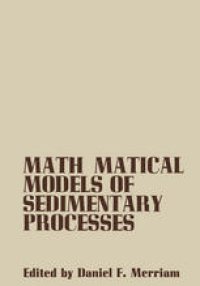
Ebook: Mathematical Models of Sedimentary Processes: An International Symposium
- Tags: Civil Engineering
- Series: Computer Applications in the Earth Sciences
- Year: 1972
- Publisher: Springer US
- Edition: 1
- Language: English
- pdf
This volume reports the results of a symposium held in Heidelberg during the International Sedimentological Congress in late August and early September, 1971. The symposium, co sponsored by the International Association for Mathematical Geology, entertained the subject, "Mathematical Models of Sedimentary Processes. " The subject is most appropriate because sedimentologists have long been concerned with processes and mechanisms of sedi ment dispersal. Much effort has gone into building physical models such as flumes, stream tables, wave tanks, wind tunnels, etc. , to help understand sedimentological processes. Quantita tive methods (especially statistics) have been utilized in summarizing these data. It is timely then with the recent developments of simulation and application of computer tech niques that a symposium be addressed to the use of "Mathematical Models of Sedimentary Processes" involving some of these new statistically oriented methods and available data bases. Experimentation in geology has been hampered by a scale factor. That is, it is difficult to find suitab. 1e materials for physical models; it is difficult to find a mechanical de vice which properly represents the forces involved; it is almost impossible to allow adequately for geologic time. Sta tistically valid models are difficult to obtain with physical models because of material replicate problems. Most problems including the time factor, however, can be eliminated with mathematical models. Mathematical models can be infinitely varied in any number of combinations easily and quickly with the computer.
Content:
Front Matter....Pages i-xi
Optimization Criteria for Mathematical Models Used in Sedimentology....Pages 1-25
Interpretation of Complex Lithologic Successions by Substitutability Analysis....Pages 27-52
Mathematical Models for Hydrologic Processes....Pages 53-80
Mathematical Search Procedures in Facies Modeling in Sedimentary Rocks....Pages 81-114
Monte Carlo Simulation of Some Flysch Deposits from the East Carpathians....Pages 115-123
Diffusion Model of Sedimentation from Turbulent Flow....Pages 125-137
Conditional Simulation of Sedimentary Cycles in Three Dimensions....Pages 139-165
Areal Variation and Statistical Correlation....Pages 167-173
Formation and Migration of Sand Dunes: A Simulation of their Effect in the Sedimentary Environment....Pages 175-190
Mathematical Models for Solution Rates of Different-Sized Particles in Liquids....Pages 191-201
A Simple Quantitative Technique for Comparing Cyclically Deposited Successions....Pages 203-231
Models for Studying the Occurrence of Lead and Zinc in a Deltaic Environment....Pages 233-245
The Semi-Markov Process as a General Sedimentation Model....Pages 247-268
Back Matter....Pages 269-271
Content:
Front Matter....Pages i-xi
Optimization Criteria for Mathematical Models Used in Sedimentology....Pages 1-25
Interpretation of Complex Lithologic Successions by Substitutability Analysis....Pages 27-52
Mathematical Models for Hydrologic Processes....Pages 53-80
Mathematical Search Procedures in Facies Modeling in Sedimentary Rocks....Pages 81-114
Monte Carlo Simulation of Some Flysch Deposits from the East Carpathians....Pages 115-123
Diffusion Model of Sedimentation from Turbulent Flow....Pages 125-137
Conditional Simulation of Sedimentary Cycles in Three Dimensions....Pages 139-165
Areal Variation and Statistical Correlation....Pages 167-173
Formation and Migration of Sand Dunes: A Simulation of their Effect in the Sedimentary Environment....Pages 175-190
Mathematical Models for Solution Rates of Different-Sized Particles in Liquids....Pages 191-201
A Simple Quantitative Technique for Comparing Cyclically Deposited Successions....Pages 203-231
Models for Studying the Occurrence of Lead and Zinc in a Deltaic Environment....Pages 233-245
The Semi-Markov Process as a General Sedimentation Model....Pages 247-268
Back Matter....Pages 269-271
....